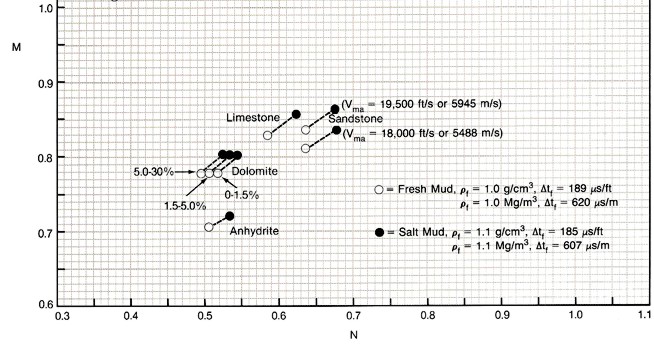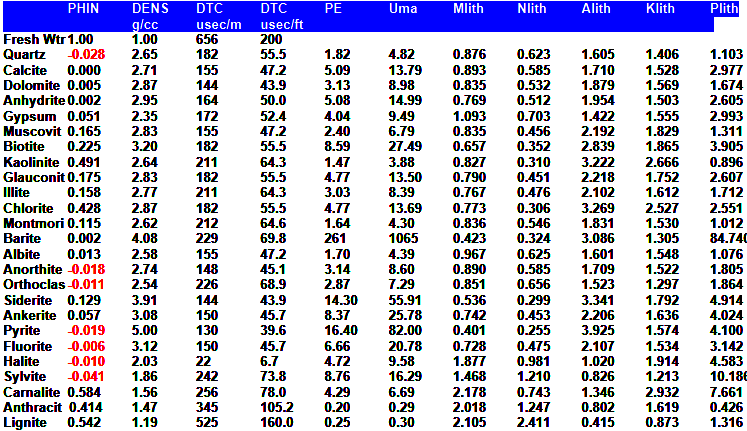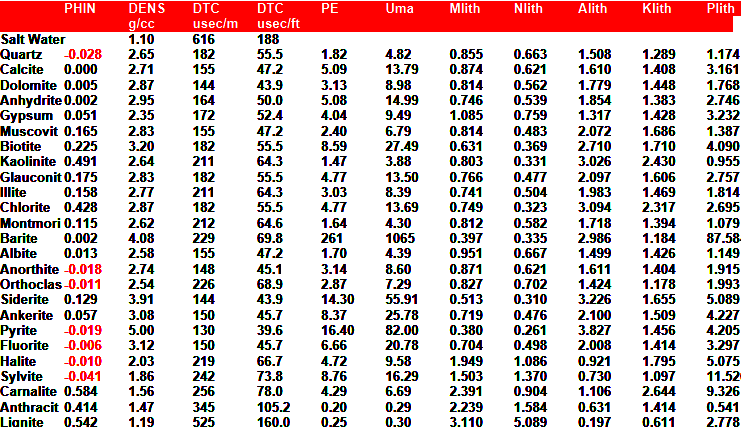|
 Lithology fRom SONIC, DENSITY, NEUTRON, PE LOGS
Lithology fRom SONIC, DENSITY, NEUTRON, PE LOGS
One method of numerically evaluating lithology is to use the Mlith-Nlith
method, which uses two formulae nearly independent of the porosity
of the rock. The input data to these algorithms must be shale
corrected, must be in limestone porosity units, and must be in
English units before processing begins. Various 2 and 3 mineral
models can be constructed from the available data - all
possible combinations are listed in this Chapter.
 Lithology fRom Mlith-Nlith
Methods
Lithology fRom Mlith-Nlith
Methods
Shale correct all data:
1:
PHIdc = PHID - Vsh * PHIDSH
2: PHInc = PHIN - Vsh * PHINSH
3: PHIsc = (DTC - (1 - Vsh) * 47.3 - Vsh * DTCSH) / (188 - 47.3)
4: DENSc = PHIdc + (1 - PHIdc) * 2.71
5: DTCc = PHIsc * 188 + (1 - PHIsc) * 47.3
Calculate Mlith and Nlith
6: Nlith = (1.00 - PHInc) / (DENSc - DENSW)
7: Mlith = 0.01 * (DTCW - DTCc) / (DENSc - DENSW)
 2-Mineral
Model Using Mlith
2-Mineral
Model Using Mlith
If the usual lithology is made up of two minerals, then the Mlith
and Nlith values can each be linearly interpolated to find the
fraction of the minerals.
8: Vmin1 = (Mlith - MLITH2) /
(MLITH1 - MLITH2)
9: Vmin2 = 1.00 - Vmin1
 2-Mineral
Model Using Nlith
2-Mineral
Model Using Nlith
10: Vmin1 = (Nlith - NLITH2) / (NLITH1 - NLITH2)
11: Vmin2 = 1.00 - Vmin1
 3-Mineral
Model Using Mlith and Nlith
3-Mineral
Model Using Mlith and Nlith
If
the usual lithology is made up of three minerals, then the Mlith
and Nlith values can be linearly triangulated to find the fraction
of the minerals.
12: D = (Mlith * (NLITH2 - NLITH1) + Nlith * (MLITH1 - MLITH2)
+ MLITH2 * NLITH1 - MLITH1 * NLITH2) / (MLITH1 * (NLITH3 - NLITH2)
+ MLITH2 * (NLITH1 - NLITH3) + MLITH3 * (NLITH2 - NLITH1))
13: E = (D * (NLITH3 - NLITH1) - Nlith + NLITH1) / (NLITH1 - NLITH2)
14: Vmin1 = MAX(0, 1 - D - E) /
(MAX(0, 1 - D - E) + MAX(0, D) + MAX(0, E))
15: Vmin2 = MAX(0, E) / (MAX(0, 1
- D - E) + MAX(0, D) + MAX(0, E))
16: Vmin3 = (1.00 - Vmin1 - Vmin2)
Where:
DTC = sonic log reading (usec/ft)
DTCc = sonic log reading corrected for shale (usec/ft)
DTCSH = sonic log reading in 100% shale (usec/ft)
DELTW = sonic log reading in 100% water (usec/ft)
DENS = density log reading (gm/cc)
DENSc = density log reading corrected for shale (gm/cc)
DENSW = fluid density (gm/cc)
Mlith = sonic density lithology factor (fractional)
MLITH1 = Mlith of first mineral (fractional)
MLITH2 = Mlith of second mineral (fractional)
MLITH3 = Mlith of third mineral (fractional)
Nlith = neutron density lithology factor (fractional)
NLITH1 = Nlith of first mineral (fractional)
NLITH2 = Nlith of second mineral (fractional)
NLITH3 = Nlith of third mineral (fractional)
PHIdc = density porosity corrected for shale (fractional)
PHIDSH = density log reading in 100% shale (fractional)|
PHIN = neutron log reading (fractional)|
PHInc = neutron log porosity corrected for shale (fractional)
PHINSH = neutron log reading in 100% shale (fractional)
PHIsc = sonic log porosity corrected for shale (fractional)
Vsh = volume of shale (fractional)
Vmin1 = relative volume of first mineral (fractional)
Vmin2 = relative volume of second mineral (fractional)
Vmin3 = relative volume of third mineral (fractional)
 COMMENTS:
COMMENTS:
NOTE:
all log data must be converted to English Units before use - usec/m
* 0.3048 = usec/ft and kg/m3 * 0.001 = g/cc.
All Vmin results must be multiplied by Vrock to get true mineral
volumes (V1, V2, V3) from relative mineral volumes. Vrock = 1.00
- PHIe - Vsh.
By comparing computed values of Mlith and Nlith with those in
the table below, or by plotting them on an Mlith - Nlith crossplot,
rock matrix can usually be identified. The method is relatively
independent of porosity, except for dolomite.
These
two variables are usually called M and N, but they can be confused
with the cementation exponent M and the saturation exponent N,
so we have changed their names to reduce confusion.
The
end points for the common minerals are plotted below.

Mlith vs Nlith crossplot for two or three mineral
models
 NUMERICAL
EXAMPLE:
NUMERICAL
EXAMPLE:
1. Assume data from 2135 - 2153 meters in Classic Example 2.
PHID = 0.015
PHIN = 0.15
DTCc = DTC = 190 usec/m = 61 usec/ft
DENSW = 1000 kg/m3 = 1.00 gm/cc
DENSMA = 2710 kg/m3 = 2.71 gm/cc
Vsh = 0.0
DENSc = 0.015 * 1.00 + (1 - 0.015) * 2.71 = 2.684
Nlith = (1.00 - 0.15) / (2.684 - 1.00) = 0.50
Mlith = 0.01 * (188 - 61) / (2.684 - 1.00) = 0.77
The
closest values in the table represent dolomite (Mlith = 0.778
and Nlith = 0.516), so this interval is very likely dolomite.
 Lithology from Alith-Klith
Methods
Lithology from Alith-Klith
Methods
The Alith-Klith method, like the Mlith-Nlith method, is used to
identify matrix lithology. The term A can be confused with the
tortuosity exponent A used in the water saturation equation, hence
we use the term Alith and Klith instead of A and K.
The
input data to these algorithms must be shale corrected, must be
in limestone porosity units and must be in English units before
processing begins.
Shale correct raw data:
21: PHIdc = PHID - Vsh * PHIDSH
22: PHInc = PHIN - Vsh * PHINSH
23: PHIsc = (DELT - (1 - Vsh) * 47.3 - Vsh * DELTSH) / (188 - 47.3)
24: DENSc = PHIdc + (1 - PHIdc) * 2.71
25: DTCc = PHIsc * 188 + (1 - PHIsc) * 47.3
Calculate Alith and Klith:
26: Alith = (DENSc - DENSW) / (1.00 - PHInc)
27: Klith = 0.01 * (DTCW - DTCc) / (1.00 - PHInc)
 2-Mineral
Model Using Alith
2-Mineral
Model Using Alith
If the usual lithology is made up of two minerals, then the Alith
and Klith values can each be linearly interpolated to find the
fraction of the minerals.
28: Vmin1 = (Alith - ALITH2) /
(ALITH1 -AMLITH2)
29: Vmin2 = 1.00 - Vmin1
 2-Mineral
Model Using Klith
2-Mineral
Model Using Klith
30: Vmin1 = (Klith - KLITH2) / (KLITH1 - KLITH2)
31: Vmin2 = 1.00 - Vmin1
 3-Mineral
Model Using Alith and Klith
3-Mineral
Model Using Alith and Klith
If
the usual lithology is made up of three minerals, then the Alith
and Klith values can be linearly triangulated to find the fraction
of the minerals.
32: D = (Alith * (KLITH2 - KLITH1) +
Klith * (KLITH1 - ALITH2)
+ ALITH2 * KLITH1 - ALITH1 * KLITH2) / (ALITH1 * (KLITH3 - KLITH2)
+ ALITH2 * (KLITH1 - KLITH3) + ALITH3 * (KLITH2 - KLITH1))
33: E = (D * (KLITH3 - KLITH1) -
Klith + KLITH1) / (KLITH1 - KLITH2)
34: Vmin1 = MAX(0, 1 - D - E) /
(MAX(0, 1 - D - E) + MAX(0, D) + MAX(0, E))
35: Vmin2 = MAX(0, E) / (MAX(0, 1
- D - E) + MAX(0, D) + MAX(0, E))
36: Vmin3 = (1.00 - Vmin1 - Vmin2)
Where:
Alith = density neutron lithology factor (fractional)
DTC = sonic log reading (usec/ft or usec/m)
DTCc = sonic log reading corrected for shale (usec/ft or usec/m)
DTCSH = sonic log reading in 100% shale (usec/ft or usec/m)
DTCW = sonic log reading in 100% water (usec/ft or usec/m)
DENS = density log reading (gm/cc or kg/m3)
DENSc = density log reading corrected for shale (gm/cc or kg/m3)
DENSW = fluid density (gm/cc or kg/m3)
Klith = sonic neutron lithology factor (fractional)
PHIdc = density porosity corrected for shale (fractional)
PHIDSH = density log reading in 100% shale (fractional)
PHIN = neutron log reading (fractional)
PHInc = neutron log porosity corrected for shale (fractional)
PHINSH = neutron log reading in 100% shale (fractional)
PHIsc = sonic log porosity corrected for shale (fractional)
Vsh = volume of shale (fractional)
 COMMENTS:
COMMENTS:
Note that Alith is the inverse of Nlith and that Klith is the
ratio Mlith/Nlith. The data for common minerals is plotted
below.
To
calculate 2 or 3 mineral models, use the same math as the
Mlith-Nlith Section, but replace Mlith with Alith and Nlith with
Klith.
 NUMERICAL
EXAMPLE:
NUMERICAL
EXAMPLE:
1. Assume the same data as before:
PHID = 0.015
PHIN = 0.15
DELT = 190 usec/m = 61 usec/ft
DENSc = 0.015 + (1.0 - 0.015) * 2.71 = 2.684
Klith = 0.01 * (188 - 61) / (1 - 0.15) = 1.52
Alith = (2.684 - 1.00) / (1 - 0.15) = 1.98
Again,
these values are close to the dolomite point, so the rock is assumed
to be dolomite.
 Lithology from
Mlith-Plith
Method
Lithology from
Mlith-Plith
Method
An alternate version of this model can be made by replacing
Nlith with Plith = PE / (DENS - DENSW) - density in gm/cc. This
avoids the use of the neutron log in cases where it has little
lithology discrimination, such as in igneous rocks.
Shale correct all data:
1:
PHIdc = PHID - Vsh * PHIDSH
2: PEc = PE - Vsh * PESH
3: PHIsc = (DTC - (1 - Vsh) * 47.3 - Vsh * DTCSH) / (188 - 47.3)
4: DENSc = PHIdc + (1 - PHIdc) * 2.71
5: DTCc = PHIsc * 188 + (1 - PHIsc) * 47.3
Calculate Mlith and Plith
6: Plith = PEc / (DENSc - DENSW)
7: Mlith = 0.01 * (DTCW - DTCc) / (DENSc - DENSW)
 2-Mineral
Model Using Mlith
2-Mineral
Model Using Mlith
If the usual lithology is made up of two minerals, then the Mlith
and Nlith values can each be linearly interpolated to find the
fraction of the minerals.
8: Vmin1 = (Mlith - MLITH2) /
(MLITH1 - MLITH2)
9: Vmin2 = 1.00 - Vmin1
 2-Mineral
Model Using Plith
2-Mineral
Model Using Plith
10: Vmin1 = (Plith - PLITH2) / (PLITH1 - PLITH2)
11: Vmin2 = 1.00 - Vmin1
 3-Mineral
Model Using Mlith and Plith
3-Mineral
Model Using Mlith and Plith
If
the usual lithology is made up of three minerals, then the Mlith
and Plith values can be linearly triangulated to find the fraction
of the minerals.
12: D = (Mlith * (PLITH2 - PLITH1) +
Plith * (MLITH1 - MLITH2)
+ MLITH2 * PLITH1 - MLITH1 * PLITH2) / (MLITH1 * (PLITH3 - PLITH2)
+ MLITH2 * (PLITH1 - PLITH3) + MLITH3 * (PLITH2 - PLITH1))
13: E = (D * (PLITH3 - PLITH1) -
Plith + PLITH1) / (PLITH1 - PLITH2)
14: Vmin1 = MAX(0, 1 - D - E) /
(MAX(0, 1 - D - E) + MAX(0, D) + MAX(0, E))
15: Vmin2 = MAX(0, E) / (MAX(0, 1
- D - E) + MAX(0, D) + MAX(0, E))
16: Vmin3 = (1.00 - Vmin1 - Vmin2)
Where:
DTC = sonic log reading (usec/ft)
DTCc = sonic log reading corrected for shale (usec/ft)
DTCSH = sonic log reading in 100% shale (usec/ft)
DTCW = sonic log reading in 100% water (usec/ft)
DENS = density log reading (gm/cc)
DENSc = density log reading corrected for shale (gm/cc)
DENSW = fluid density (gm/cc)
Mlith = sonic density lithology factor (fractional)
Plith = PE density lithology factor (fractional)
PHIdc = density porosity corrected for shale (fractional)
PHIDSH = density log reading in 100% shale (fractional)|
PE = photo electric log reading (fractional)|
PEc = photo electric log corrected for shale (fractional)
PESH = photo electric log reading in 100% shale (fractional)
PHIsc = sonic log porosity corrected for shale (fractional)
Vsh = volume of shale (fractional)
 COMMENTS:
COMMENTS:
This
model is very effective in granite reservoirs.
To
calculate 2 or 3 mineral models, use the same math as the
Mlith-Nlith Section, but replace Nlith with Plith.
 MATRIX
ROCK PARAMETERS
MATRIX
ROCK PARAMETERS


|

